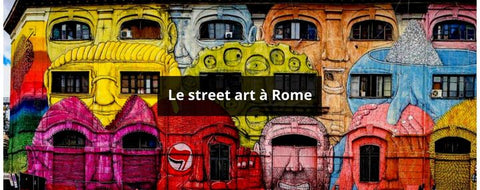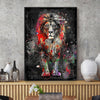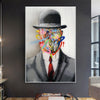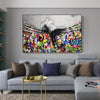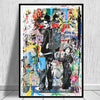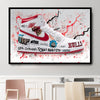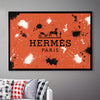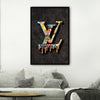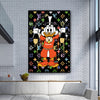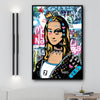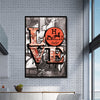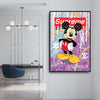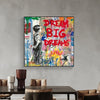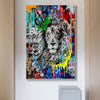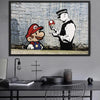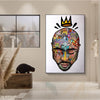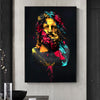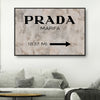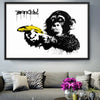
What is Pop Art?
Are you an art enthusiast? Then you've probably already heard of the Pop Art movement. But do you really know how to define it? If the answer is no, then this article is for you! Indeed, we're going to talk exclusively about the Pop Art movement today: its definition, its influence, and more.
Pop Art was one of the most popular artistic movements of the 1950s. It originated in Great Britain but quickly spread throughout the world. Today, many artists continue to keep it alive.
But what exactly is it? To answer that, we will look at the following elements:
- The definition of pop art
- The history of pop art
- The movements that influenced pop art
- The characteristics of pop art
- The great iconic artists of pop art
By reading this article, you will become more familiar with this world and finally understand its true meaning.

I) Pop Art: what is it?
Art, which has existed for millennia, is an integral part of our lives. It soothes us, guides us, and allows us to express ourselves freely and without oppression . Like any movement, art has evolved over time. We have seen the rise and fall of Mannerism, Naturalism, Futurism, Expressionism, Pop Art , Urban Art, Free Figuration, Bio-Art, and so on. While most of these movements lasted only a few years, some have endured. This is the case with Pop Art. But what exactly is it?
Etymologically, pop art is derived from the English words "popular" and "art." By this name, pop art is therefore the art of the masses , of the majority, and especially of popular culture. It emerged in the 1950s, at a time when the media world was beginning to flourish globally. The prevailing trends of the era were thus more focused on advertising, comic books , science fiction , cinema, and celebrity. Pop art aims, in particular, to represent these elements through images and canvases.

II) Pop Art: how did it appear?
The Pop Art movement emerged in England in the 1950s. At that time, the world had just emerged from World War II. The war's impact sparked a desire for freedom among the English, especially young people. Many painters sought to express this desire through their canvases, drawing inspiration from the most fashionable events of the period. This is how Pop Art was born!
The concept immediately appealed to the general public, as it was innovative and accessible to everyone. Indeed, until then, the art world had been primarily reserved for elitists, the bourgeoisie, and high society . Thanks to pop art, middle-class people, or even the poorest members of society, could, in a way, liberate themselves and express their views.
In 1952, several leading pop artists such as Eduardo Paolozzi and Richard Hamilton founded the "Independent Group" : an association dedicated exclusively to the promotion of pop art. They met regularly with the aim of developing art and finding new innovations.

While Pop Art initially focused primarily on British mass culture, it quickly turned its attention to the United States in 1956. American culture had undeniably captivated many artists. Indeed, a growing number of painters emerged in the US, including Andy Warhol , who became the leading pioneer of Pop Art, and Roy Lichtenstein with his science fiction and comic book-inspired works.
Pop art continued to flourish, not only in Europe and America, but also worldwide. Artists emerged all over the globe: in Japan, Russia, and elsewhere. Pop art exhibitions and events also proliferated over time. Since then, it has no longer been considered simply a popular urban art form , but rather a sophisticated art form.
III) Pop Art: what artistic movements did it draw inspiration from?
Although pop art is a unique movement, it was nonetheless influenced by many other artistic currents. Among these, we can mention expressionism and dadaism.
As a reminder, Expressionism is an art form that aims to translate aspects of reality into dynamic figures, thereby capturing the viewer's attention . This movement emerged primarily at the beginning of the 20th century, thanks to a group of painters called Die Brücke. It notably influenced Pop Art culture, as both depict real-life events. They also share a similar approach to drawing format. Like Expressionists, Pop Art artists often work on a large scale.
As for Dadaism, it is a movement that emerged at the beginning of the 20th century. While most artistic movements tend to express the beauty of nature, of the world in all its forms, this one tends instead to destroy it, or more precisely, to challenge it . In the Dada movement, all ideological, aesthetic, and political conventions are questioned.
The aim is to challenge established norms in order to understand true reality. Pop art shares some similarities with this movement, given its bold and provocative nature. It doesn't hesitate to distort reality. However, they also have many differences. Instead of destroying reality, pop art seeks to reshape it, which is contrary to the principles of Dadaism.

Aside from artistic movements, Pop Art was also heavily influenced by consumer society. As mentioned earlier, the 1950s were marked by the widespread popularization of media . Television had a profound impact on people's daily lives, to the point that they tended to base their opinions on what they saw on TV. Media thus became a kind of standard that everyone had to follow. Product manufacturers capitalized on this popularity to promote their products; and thanks to various advertisements, consumption skyrocketed, even encouraging waste. Pop Art, therefore, aimed to express this experience of modern-day consumption .
Finally, pop art also coincided with the pop music movement of the 1950s and 60s. Many painters absorbed this culture, transforming it into art. It is therefore not uncommon to see portraits of celebrities in the works of the great artists of the era. This is notably the case with Andy Warhol's portrait of the famous Marilyn Monroe .
IV) Pop Art: what are its characteristics?
Pop art is often dismissed as a banal art form, lacking real creativity. Yet, it has captivated millions of viewers worldwide. This popularity is undoubtedly due to its simplicity and ordinariness. Indeed, it simply reflects people's everyday lives. It depicts the news of the time, what was trendy, and how people experienced it. But it's also an excellent way to add color to your home. At Lofty Trend, that's precisely what we strive to achieve through our Pop Art creations .
It was therefore unsurprising that the painting depicted a simple Campbell's can or a Coca-Cola can, as these perfectly reflected the lifestyle of the time. However, even though Pop Art is a simplistic art form , it is far from being a trivial art form. Behind these drawings lay profound messages, connotations intended to elicit a reaction from viewers . The drawings were also presented with more aesthetic aspects to attract the attention of art lovers.
It's also worth noting that pop art artists used a lot of color in their paintings. This reflects the movement's vibrant and welcoming atmosphere .
Regarding the techniques used, pop art painting was based primarily on collage and assemblage, a system derived from Cubism and Surrealism . It is therefore not uncommon to see many artists cutting out magazine clippings and pasting them onto a canvas along with other trendy elements of the time.

Finally, the themes addressed in the pop art movement mainly concerned product advertisements, television stars, films and cartoon characters, fashion and occasionally, politics.
V) Pop Art: who are the artists who popularized it?
Eduardo Paolozzi can be considered the founding father of pop art . However, he is not the only one to have popularized it, and in fact, he is far from being the most famous figure in the field. Here are some of the great artists who shaped pop art:
Andy Warhol (1928-1987) : Born in Pittsburgh, he is one of the iconic artists of Pop Art. He is best known for his striking portraits, including that of Marilyn Monroe, which remains one of the most expensive paintings in the world. He also created the famous "Factory," which became a hub for Pop Art expression and dedication.

Roy Lichtenstein (1923-1997) : You can't talk about pop art without mentioning Roy Lichtenstein (a black and white photo of him is shown above) . He is best known for his offbeat, somewhat supernatural works, leaning a bit towards science fiction and the depiction of cartoon characters.
Pauline Boty (1938-1966) : she is one of the few women to have gained recognition through her pop art works. During her lifetime, she focused primarily on feminism, highlighting the beauty of women.

Richard Hamilton (1922-2011) : Richard Hamilton was one of the founders of the Independent Group , alongside Eduardo Paolozzi. He thus contributed to the development and flourishing of the Pop Art movement. One of his best-known works is "Just What Is It that Makes Today's Homes So Different, So Appealing?" in which he questions mass consumption.
By reading this article, you have been able to strengthen your knowledge in the field of art, more specifically regarding the world of Pop Art . Now, you will be able to discuss or talk about this artistic movement with your family and friends.
To thank you for making it this far, enjoy a 15% discount on your order today with the promo code: BLOG15 .
See you soon.
The Lofty Trend Team.






